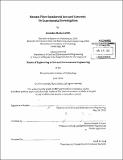Natural fiber reinforced aerated concrete : an experimental investigation
Author(s)
Garbis, Leonidia Maria
DownloadFull printable version (12.98Mb)
Other Contributors
Massachusetts Institute of Technology. Department of Civil and Environmental Engineering.
Advisor
Jerome Joseph Connor.
Terms of use
Metadata
Show full item recordAbstract
The purpose of this study is to compare existing research with aerated concrete and fiber reinforcement to original experiments completed investigating the benefits of adding natural fiber tensile reinforcement to aerated concrete. Concrete is a great composite material which can be created in various proportions and with various materials to alter its strength, density and porosity, amongst other properties. Concrete which is used commonly in construction of columns, beams, and slabs acts well in compression but fails under tension. The common solution is to reinforce the structure in areas where it experiences tension with steel. There are other materials besides steel which also take tension well. Natural fibers for example come in various strengths and types and would create lighter and perhaps more sustainable beam designs. Natural fibers have been used for their availability, workability, and high tensile strengths for centuries. This research discovers that the compressive strength of this cellular material can support the construction of a small structure, assuming accuracy of previous experimental results. These previous experiments discover how the natural fibers distribute within the mixture and how they affect the aeration of the concrete, as well as how they affect the strength. Multiple samples are cured with different fiber types and in different proportions within the mixture. Furthermore, similar experimentation is conducted to discover an ideal ratio of aggregate to aerated concrete mix. The aggregate gives the concrete greater strength and economy, but could negatively affect the aeration. The various concrete mixes are poured and allowed to cure to maximum strength before indirect tensile tests and compression tests are conducted. The effects of creating smooth aerated concrete molds are also investigated. All experiments conducted are precursory to an ultimate tensile reinforced aerated concrete beam design with an aggregate mix and smooth surfaces.
Description
Thesis (M. Eng.)--Massachusetts Institute of Technology, Dept. of Civil and Environmental Engineering, 2013. Cataloged from PDF version of thesis. Includes bibliographical references (p. 51-52).
Date issued
2013Department
Massachusetts Institute of Technology. Department of Civil and Environmental EngineeringPublisher
Massachusetts Institute of Technology
Keywords
Civil and Environmental Engineering.